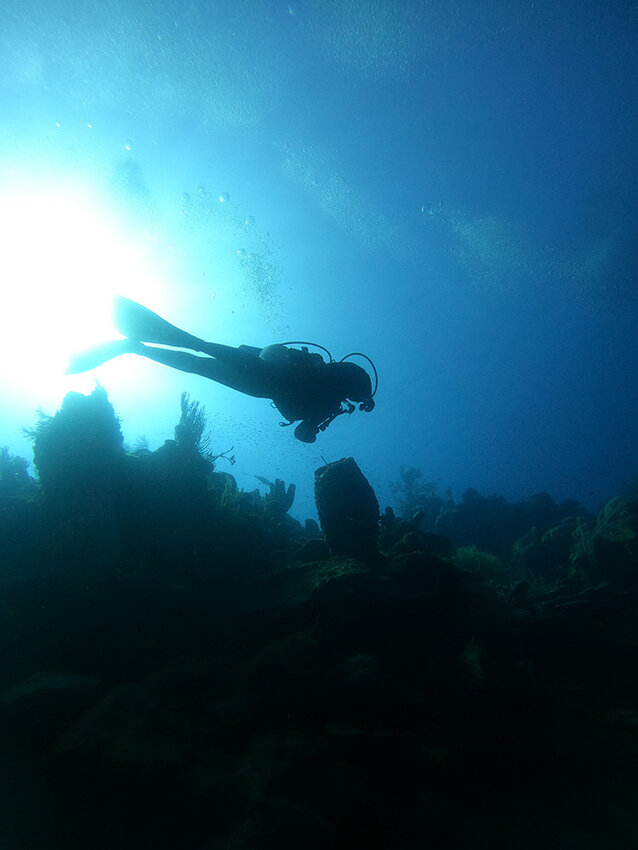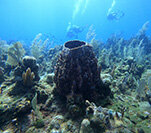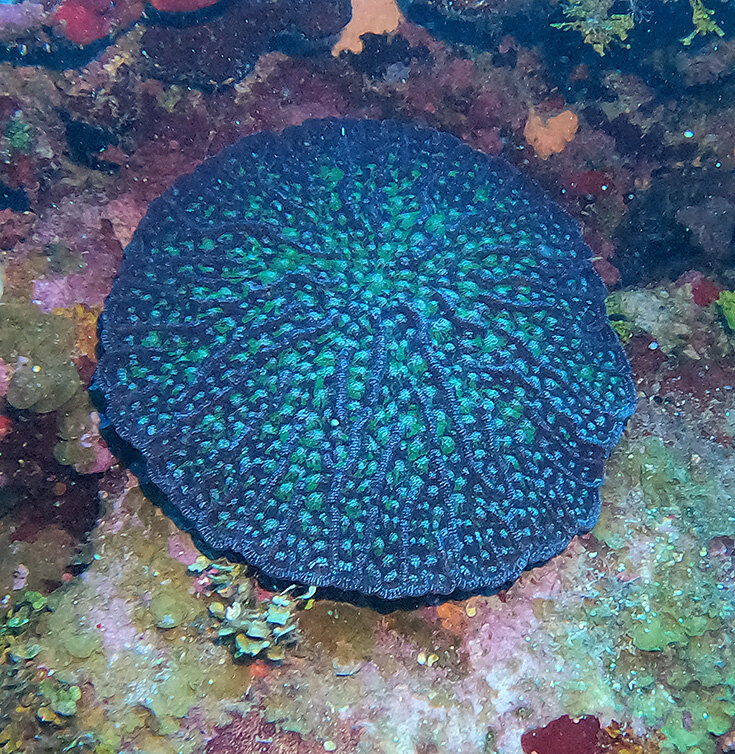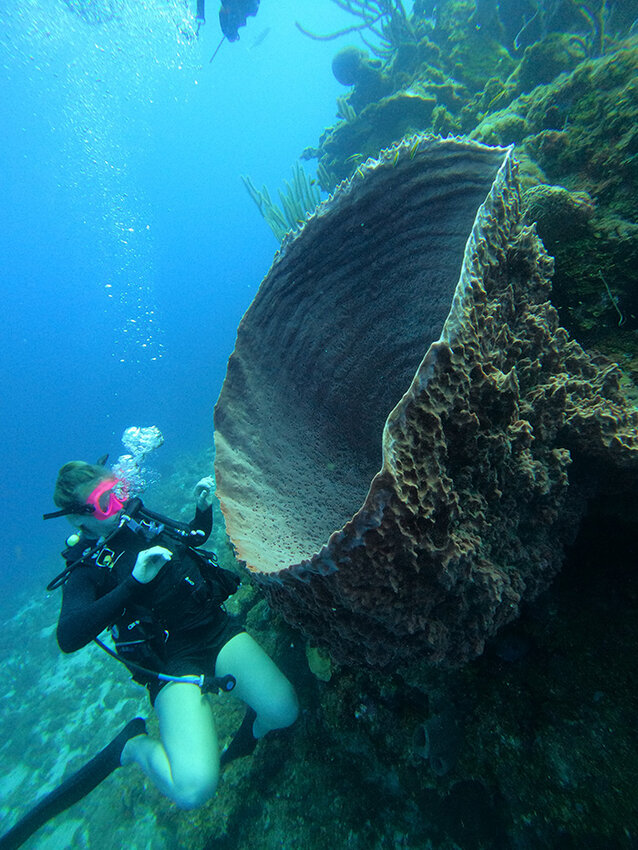 A diver's paradise
A diver's paradiseIn June, my daughter Alex called me up out of the blue from San Francisco and asked if I wanted to go on a dive trip to Roatan, an island off the coast of Honduras in central America. “Come on,” she said, “It will be a bonding experience.” An underwater bonding experience? How is that even possible, I asked myself. But, to paraphrase Lord Tennyson’s poem about the charge of the Light Brigade, ours is not to question why, ours is but to do or dive.
That’s how we found ourselves taking a flight from SFO through Dallas to Juan Manuel Galvez International Airport on Roatan, a trip taking about seven hours in total. We were headed to Barefoot Cay, a dive resort about 20 minutes from the airport and close to the island’s capital city, Coxen Hole. The town of about 5,000 people is named after Captain John Coxen, a buccaneering pirate who plundered throughout the Spanish Main during the late 17th Century. At that time, Roatan was home to around 5,000 pirates and their hangers-on.
The island is the largest of the Bay Islands, about 40 miles off the coast of northern Honduras and is a department of that country. Oriented on an east to west axis, the island is about 30 miles long and just 5 miles across at its widest point. It sits on an ancient coral reef abutter the Mesoamerican Reef which, at over 700 miles long, is the second largest barrier reef system in the world, the first being the Great Barrier Reef in Australia.
 The reef contains well over 100 dive spots surrounding the entire island; the entire reef system is protected by local and federal law with a number of conservation organizations working to protect and preserve the sensitive environment. For example, in 2019 the sale and use of plastic bags, bottles, containers and styrofoam was outlawed by the local government. Local schools and organizations hold regular clean-up programs and dive shops pick up debris on most dives. New sewer systems have been built and irrigation and runoff impacts have been mitigated to help protect the reef and the economy created by it.
The reef contains well over 100 dive spots surrounding the entire island; the entire reef system is protected by local and federal law with a number of conservation organizations working to protect and preserve the sensitive environment. For example, in 2019 the sale and use of plastic bags, bottles, containers and styrofoam was outlawed by the local government. Local schools and organizations hold regular clean-up programs and dive shops pick up debris on most dives. New sewer systems have been built and irrigation and runoff impacts have been mitigated to help protect the reef and the economy created by it.
Barefoot Cay is one of many dive resorts on the island and it came well-recommended by friends of my daughter. It was purchased from the original owner in 2020 by a Guatemalan businessman who wasted no time renovating and refreshing the small resort.
The cay itself holds the Silversides Restaurant & Bar, pool and oceanfront villas and palapa. A narrow channel separates the cay from the mainland where the diveshop and boats are located. A fleet of two pontoon boats takes guests across in under 30 seconds and runs 24/7.
 Diving in Roatan is about as reasonable as it gets these days. A five-day, 10-dive package at Barefoot Cay costs $350; make one or more dives over that and the price drops to $30 per dive. That price includes weights and tanks. The dive shop also offers advanced courses as well as learn to dive programs.
Diving in Roatan is about as reasonable as it gets these days. A five-day, 10-dive package at Barefoot Cay costs $350; make one or more dives over that and the price drops to $30 per dive. That price includes weights and tanks. The dive shop also offers advanced courses as well as learn to dive programs.
 Why is diving so inexpensive in Roatan? Many of the dive sites are within 5 or 10 minutes of the dock so the operators aren’t spending a lot of money on diesel. Still, this is not econo-style diving – Barefoot Divers calls it valet diving.
Why is diving so inexpensive in Roatan? Many of the dive sites are within 5 or 10 minutes of the dock so the operators aren’t spending a lot of money on diesel. Still, this is not econo-style diving – Barefoot Divers calls it valet diving.
Divemaster Daniel and boat captain Justin make sure of that. Your tank and BCD are set on the boat, you hand your mask to a crewmember who cleans, de-fogs and hands it back to you; the captain grabs the tank stem and takes the weight off you as you stand and walk to the back of the boat; the divemaster escorts you around the dive site, pointing out things of interest that you would otherwise swim past without noticing; you pass your mask and fins up to the captain back at the boat, he again takes the weight off you as you climb the ladder and retake your seat; and finally, he hands you a container of ice-cold watermelon to quench your thirst after breathing compressed air for the last 40-50 minutes.
This was the easiest diving I have ever done in my life and I’ve done a bit of diving around the world: B.C., Great Barrier Reef, the Red Sea, the Maldives, Hawaii, Truk Lagoon (Chuuk) in Micronesia and elsewhere. My daughter, on the other hand, had only dived off of Monterey, California. I didn’t have the heart to tell her that the first time I dove in tropical waters was when I decided I would never dive in cold water again. Here in Roatan, the water was 86 degrees F (30° C) at depth, meaning no wetsuit or rash guard necessary. Visibility ranged from 70–100 feet which is just fine in my opinion.
 Marine life is abundant. Turtles, eels, eagle rays were commonly seen; however, we missed seeing whale sharks or sharks of any kind, for that matter. Barrel sponges were huge and everywhere, soft and fan corals predominated – you could probably spend a whole dive looking at 10 square feet of marine life and feel it was one of the best dives ever. You won’t but you could.
Marine life is abundant. Turtles, eels, eagle rays were commonly seen; however, we missed seeing whale sharks or sharks of any kind, for that matter. Barrel sponges were huge and everywhere, soft and fan corals predominated – you could probably spend a whole dive looking at 10 square feet of marine life and feel it was one of the best dives ever. You won’t but you could.
In these pandemic days, you need to go through a few hoops to enter Honduras and Roatan. If you’re not fully vaccinated, you’ll need a Covid-19 test. These need to be uploaded to a government website before you board the plane.
 I’ll let you know now – this is not the easiest procedure and you’ll want to give yourself plenty of time to do so. Expect the site to freeze or to suddenly revert to Spanish even though you chose the English version. It’s a pain but it’s worth it.
I’ll let you know now – this is not the easiest procedure and you’ll want to give yourself plenty of time to do so. Expect the site to freeze or to suddenly revert to Spanish even though you chose the English version. It’s a pain but it’s worth it.
Most of the dive resorts have the latest information on their websites so check there first. For more information about Barefoot Cay, go to barefootcay.com.
(Note: We paid full-price for our stay and did not receive any promotional consideration from the resort.) x